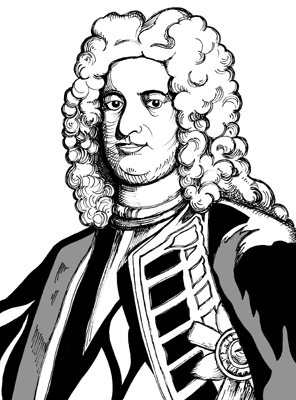William Cadogan, Earl Cadogan (1672-1726) (original) (raw)
 William Cadogan ,
Earl Cadogan (1672-1726)
William Cadogan ,
Earl Cadogan (1672-1726)
Born: 1672 at Liscarton, Co. Meath, Ireland
Baron Cadogan of Reading
Baron Cadogan of Oakley
Viscount Caversham
Earl Cadogan Died: 17th July 1726 at Kensington, Middlesex
William was the son of Henry Cadogan, an Irish barrister, by his wife, Bridget, the daughter of Sir Hardress Waller. His grandfather had been a stout Cromwellian soldier. William served under King William III in Ireland and in the Low Countries, and was Marlborough's Quartermaster-General and right hand through the War of the Spanish Succession. The victories of Schellenberg (where he was wounded), Blenheim, Ramillies, Oudenarde and Malplaquet owed much to his excellent execution of the great commander's plans; so did the Sieges of Douay and Bouchain. He retained his place even under Marlborough's successor, Ormonde, but did not return to England at the end of 1712. He served in the civil capacity of Ambassador to the United Provinces in 1707, and had a seat in Parliament from 1705 onwards. He was made Lieutenant of the Tower in 1710, but was involved in the disgrace which it pleased the ungrateful English Government to throw upon Marlborough at the close of his career of victory, and in 1712 was deprived of his Lieutenancy and rank in the Army. He regained Court favour and rank on the accession of George I, went again as Minister to the United Provinces, succeeded Argyll in the command of the Hanoverian Army against the Jacobites in the campaign in Scotland in 1715-16, and finished off that task with energy and cruelty. He was raised to the peerage was the result of his success, being made Baron Cadogan of Reading where he had lately purchased Caversham Park. In the next year, 1717, he was accused of peculation (apparently as a party move started by the Jacobites, but followed up by some of the out-of-place Whigs), acquitted, and made an Earl. He succeeded Marlborough as Commander-in-Chief in 1722, and had a lawsuit with Duchess Sarah about some money of the Duke with which he had been entrusted. The Earl enjoyed a friendly rivalry with Marlborough in private as well as public life and, as the Duke had done at Woodstock, pulled down the old house at Caversham in order to rebuild in the latest fashion. Their competitiveness in the garden stakes was legendary. Historians have expressed the highest opinion of his abilities as a soldier and military administrator; the opinion of contemporaries on his career as a Minister in Holland was not so favourable.
Edited from CRL Fletcher's "Historical Portraits" (1919)
